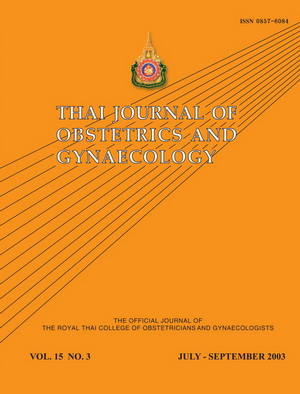Prevalence and Predicting Factors for Pelvic Lymph Node Metastasis in Stage IB1 Cervical Carcinoma
Main Article Content
Abstract
Objective To determine the prevalence of pelvic nodal metastasis and predicting factors in women with stage IB1 carcinoma of the cervix who underwent radical hysterectomy and pelvic lymphadenectomy.
Design Cross sectional analytic study.
Setting Department of Obstetrics & Gynecology, Faculty of Medicine, Chiang Mai University.
Subjects Patients with stage IB1 carcinoma of the cervix who underwent radical hysterectomy and pelvic lymphadenectomy at Chiang Mai University Hospital between January 2000 and December 2002.
Results Of 251 evaluable patients, radical hysterectomy was performed in 232 patients (92%)
and was abandoned in 19 patients (8%). The prevalence of lymph node metastasis was 24%. Patient’s age, gross tumor description, and preoperative treatment were no statistic significantly associated with pelvic lymph node metastasis. Histologic grade, depth of invasion, lymphvascular space invasion, parametrial invasion, and uterine invasion were significantly correlated with pelvic lymph node metastasis. From logistic regression analysis, the independent predicting factors for pelvic nodal metastasis were lymphvascular space invasion ( p < 0.0001) and parametria! invasion ( p = 0.02 ).
Conclusion The prevalence of pelvic lymph node metastasis in stage IB1 carcinoma of the cervix is 24%. The strongest predicting factors of node metastasis are lymphvascular space invasion and parametrial invasion.


